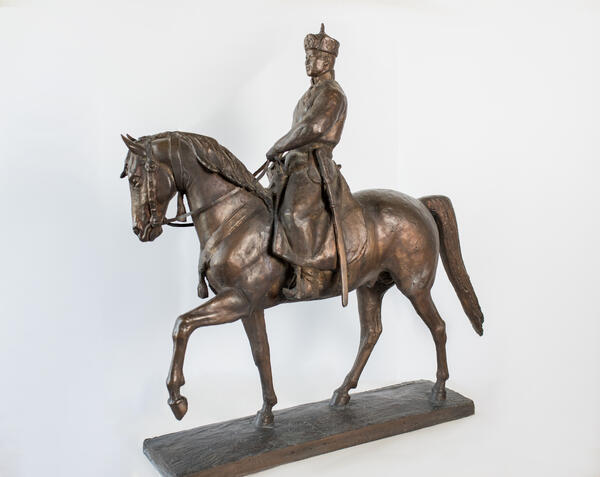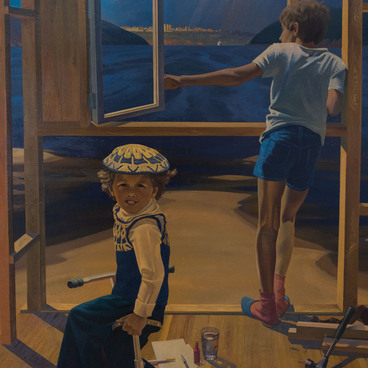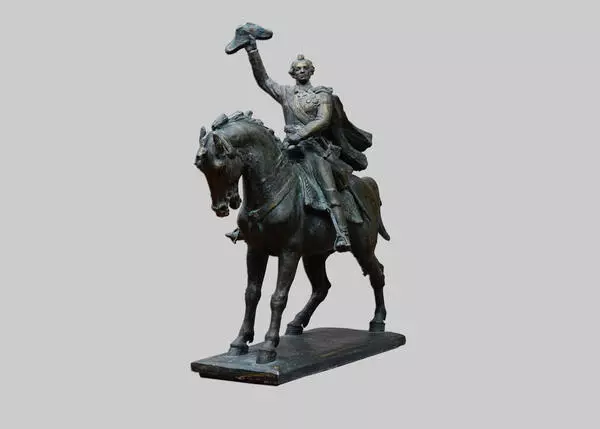The bronze sculpture “Sükhbaatar” was created by artist Anatoly Posyado in the middle of the 20th century. He depicted Sükhbaatar Damdin, the leader of the Mongolian People’s Revolution of 1921.
The proud straight-backed rider with an open face looks into the distance. He holds the reins with his left hand and a book with his right. The man is dressed in a national Mongolian robe and wears an order on his chest and a Budenovka headdress with a star on his head. On his left side, his belt holds a saber.
Sükhbaatar Damdin was born on February 2, 1893. His great-grandfather and grandfather were horse thieves who robbed the rich and gave the spoils to poor families. When Sükhbaatar was 6 years old, his family moved to the Russian Consulate area in Urga, the then capital of Mongolia, where he learned a little Russian. At 16, Sükhbaatar became a coachman.
After the Mongolian Revolution of 1911 in Outer Mongolia, which resulted in the country gaining independence from China with the support of the Russian Empire, Sükhbaatar was drafted into the army of the ruler Bogd Khan VIII. He studied at a military school, which was established through the assistance of Russian military advisers, and was promoted to lieutenant in a machine gun company. In 1918, already being the platoon leader of the machine gun company, Sükhbaatar distinguished in battle, for which he received the honorable title of the Mongolian and Turkic people — Bator (Hero).
After the 1917 October revolution, independent Outer Mongolia lost Russian support, and in 1919, China moved to re-exert its rule. In October, General Xu Shuzheng occupied Urga and soon the entire country. The monarch Bogdo Khan was deprived of power.
Two secret groups were founded in Urga, and Sükhbaatar was a member of one of them. They managed to get in touch with the Russian Bolsheviks who lived in Urga, and they persuaded the rebels to go to Irkutsk. In the summer of 1920, Sükhbaatar went to Russia as part of the new Mongolian People’s Party.
In Russia, the group split up: some of the participants went to Omsk and Moscow, some returned to Urga to recruit new people, while Sükhbaatar stayed in Irkutsk to learn the military craft and keep the connection between all of them. Before leaving, the group wrote a revolutionary manifesto promising to proclaim a people’s government in Mongolia instead of the monarchy and asking for military assistance from the RSFSR.
Meanwhile, after an assault on February 1–4, 1921, Urga was occupied by White General Roman von Ungern-Sternberg. The Bogd Khan rule was reinstated. This prompted Vladimir Lenin to provide military assistance to the rebels.
At the beginning of March 1921, an army was created headed by Sükhbaatar. On March 18, Sükhbaatar’s troops succeeded in taking the town of Maimachen and defeated the Chinese garrison. At the end of May, Ungern’s army was defeated while trying to take Khiagt, and on July 6, the revolutionary troops of Sükhbaatar entered Urga. The Bogdo-khan gave him the state seal — the symbol of the supreme power in the country. On September 23, 1922, Sükhbaatar became the first Hero of the Mongolian People’s Republic.
On February 14, 1923, after the inspection of the guards, Sükhbaatar caught a cold and died in six days.
The proud straight-backed rider with an open face looks into the distance. He holds the reins with his left hand and a book with his right. The man is dressed in a national Mongolian robe and wears an order on his chest and a Budenovka headdress with a star on his head. On his left side, his belt holds a saber.
Sükhbaatar Damdin was born on February 2, 1893. His great-grandfather and grandfather were horse thieves who robbed the rich and gave the spoils to poor families. When Sükhbaatar was 6 years old, his family moved to the Russian Consulate area in Urga, the then capital of Mongolia, where he learned a little Russian. At 16, Sükhbaatar became a coachman.
After the Mongolian Revolution of 1911 in Outer Mongolia, which resulted in the country gaining independence from China with the support of the Russian Empire, Sükhbaatar was drafted into the army of the ruler Bogd Khan VIII. He studied at a military school, which was established through the assistance of Russian military advisers, and was promoted to lieutenant in a machine gun company. In 1918, already being the platoon leader of the machine gun company, Sükhbaatar distinguished in battle, for which he received the honorable title of the Mongolian and Turkic people — Bator (Hero).
After the 1917 October revolution, independent Outer Mongolia lost Russian support, and in 1919, China moved to re-exert its rule. In October, General Xu Shuzheng occupied Urga and soon the entire country. The monarch Bogdo Khan was deprived of power.
Two secret groups were founded in Urga, and Sükhbaatar was a member of one of them. They managed to get in touch with the Russian Bolsheviks who lived in Urga, and they persuaded the rebels to go to Irkutsk. In the summer of 1920, Sükhbaatar went to Russia as part of the new Mongolian People’s Party.
In Russia, the group split up: some of the participants went to Omsk and Moscow, some returned to Urga to recruit new people, while Sükhbaatar stayed in Irkutsk to learn the military craft and keep the connection between all of them. Before leaving, the group wrote a revolutionary manifesto promising to proclaim a people’s government in Mongolia instead of the monarchy and asking for military assistance from the RSFSR.
Meanwhile, after an assault on February 1–4, 1921, Urga was occupied by White General Roman von Ungern-Sternberg. The Bogd Khan rule was reinstated. This prompted Vladimir Lenin to provide military assistance to the rebels.
At the beginning of March 1921, an army was created headed by Sükhbaatar. On March 18, Sükhbaatar’s troops succeeded in taking the town of Maimachen and defeated the Chinese garrison. At the end of May, Ungern’s army was defeated while trying to take Khiagt, and on July 6, the revolutionary troops of Sükhbaatar entered Urga. The Bogdo-khan gave him the state seal — the symbol of the supreme power in the country. On September 23, 1922, Sükhbaatar became the first Hero of the Mongolian People’s Republic.
On February 14, 1923, after the inspection of the guards, Sükhbaatar caught a cold and died in six days.



